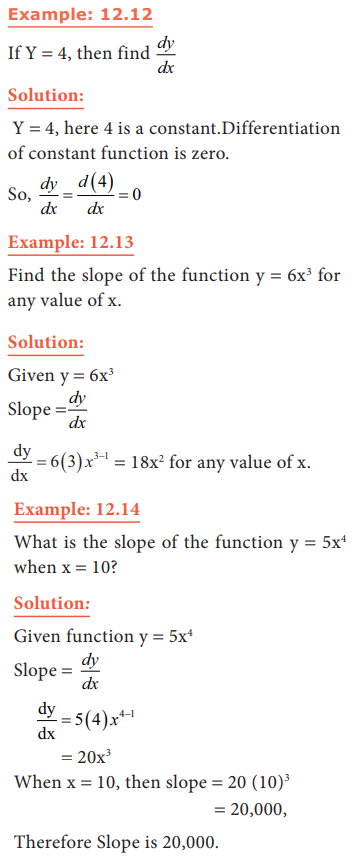Meaning, Some Standard Forms, Formula, Solved Example Problems, Application | Economics - Differential Calculus | 11th Economics : Chapter 12 : Mathematical Methods for Economics
Chapter: 11th Economics : Chapter 12 : Mathematical Methods for Economics
Differential Calculus
DIFFERENTIAL
CALCULUS
1. Meaning
The
fundamental operation of calculus is differentiation. Derivative is used to
express the rate of change in any function. Derivative means a change in the
dependent variable with respect to small change (closer to zero) in independent
variable.
Let the
function be,
y = f(x)
Differentiating
y with respect to x is,

2. Some Standard Forms of Differentiation
(Constant,
addition and subtraction only)



3. Application of Differential Calculus
The
relation between two or more variables can be expressed by means of a function.
Continuous functions alone are differentiable. For instance, the differential
calculus is applicable for finding the following:
1.
The rate of change in demand with respect to price
(in micro economics)
2.
The rate of change in income with respect to the
investment. (in macroeconomics) .
4. Marginal concepts
Marginal
concept is concerned with variations of Y (on the margin of X), that is, it is
the variation corresponding in Y to a very small variation in X. (X is the
independent variable and Y is the dependent variable)
5. Marginal Product
Marginal
product of a factor of production refers to addition to total product due to
the use of an additional unit of a factor.
MP =
d(TP)/dQ = ∆TP/∆Q
6. Marginal Cost
Marginal
cost is an addition to the total cost caused by producing one more unit of
output. In symbols:

Where, ∆TC represents a change in total cost and
∆Q represents a small change in output
or quantity. (in economics one worker, one output etc are assumed to be very
small units)
Example: 12.17
Given the
total cost function, TC = 15 + 3Q2+7Q3, drive the marginal cost function.
Solution:
TC = 15 + 3Q2 + 7Q3

=0+3(2)Q2-1 + 7(3)Q3-1
MC = 6Q +21Q2
7. Marginal Revenue
Marginal
Revenue is the revenue earned by selling an additional unit of the product. In
other words, Marginal Revenue is an addition made to the total revenue by
selling one more unit of the good.

Where ∆TR stands for change in the total
revenue, and ∆Q stands for change in
output.
Example: 12.18
Given TR = 50Q - 4Q2,find marginal
revenue when Q = 3.
Solution:
TR = 50Q - 4Q2
MR = d(TR)/dQ
MR = 50(1)Q1-1 - 4(2)Q2-1
=50(1)Q0
- 8 Q1
=50(1) - 8Q (∴Q0 = 1,Q1=Q)
MR = 50 - 8Q
When Q = 3
MR = 50 -8(3) =26
Example: 12.19
A
producer has the total cost function TC (Q) = Q3 - 18Q2 + 91Q + 10 wherecosts are given in rupees. Find the marginal cost (MC) and the
average variable cost (AVC), when Q =3.
Solution:
Given
TC(Q) = Q3 - 18Q2 + 91Q + 10, To find MC differentiate the function with respect to Q.

Example: 12.20
A
manufacturer estimates that, when units of a commodity are produced each month
the total costs will be TC(Q) = 128 + 60Q + 8Q2 Find the marginal cost, average cost, fixed cost,
variable cost, average fixed cost and average variable cost.
Solution:
Given
that TC(Q) = 128 + 60Q + 8Q2
We know
TC = Fixed cost + variable cost

∴AVC = 60 + 8Q
8. Elasticity of Demand
Elasticity
of Demand is the ratio of the proportionate change in quantity demanded to the
proportionate change in price. In mathematical terms,

In demand
function Q = a–bP
So, e =
(dQ/dP)(P/Q)
Example 12.21

Related Topics